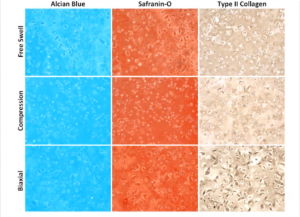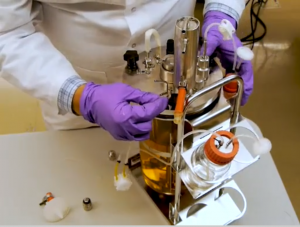Happy National Engineering Week!
Throughout my education, I have seen that students respond better to dynamic learning — having a firsthand experience by doing it themselves or watching key techniques and concepts visualized to better understand context – rather than static learning via textbooks and verbal instruction. This is especially true for undergraduates in the engineering disciplines where students typically learn by doing and creating.

It wasn’t all that long ago that I was an undergraduate pursuing an engineering degree. Currently, I am a graduate student in the 6th year of my Ph.D. in Biomedical Engineering at Boston University. I’ve also been on the other side of the equation; I have been a teaching assistant for a medical device design class and trained several undergraduates in the lab. I did my undergraduate studies in Bioengineering at UC Berkeley, another major research (R01) university, where I took a breadth of lecture and laboratory classes in the sciences (chemistry, physics, biology, bioengineering).
After seeing Dr. Namrata Sengupta speak at BU about her work at JoVE, I reached out to JoVE for opportunities to collaborate. Given my background, JoVE asked me to focus on a review of the bioengineering video collection, which spans the fundamental topics of biomaterials, biosensing, and tissue engineering. I said yes because I personally have seen students struggle with certain concepts in bioengineering as they’re hard to learn from a textbook. It’s also a cutting-edge field and exactly the type of science that excites undergraduates and keeps them interested.
Keeping Students Excited Despite The Learning Curve
Undergraduates have a difficult time getting firsthand experience with these topics. The first barrier to entry: lab safety. Before entering a lab, extensive training must be performed about proper lab attire, personal protective equipment, emergency procedures, biohazardous waste risks, and disposal, as well as experiment-dependent safety, such as recombinant DNA, UV radiation, and chemical hazards. These training modules are often online and in-person and can take weeks to months, depending on the institution.
Once the undergraduate has completed the appropriate training, they will learn to do experiments correctly and reliably under the guidance of a graduate student or postdoctoral researcher. There is often a steep learning curve, as experiments typically involve complex protocols and several days of preparation, which may not be feasible for an undergrad juggling class, extracurriculars, and social activities. Experiments require a high level of dexterity, precision, and skill acquired with practice.

Biological systems are living materials that can be highly sensitive to external contaminants, requiring additional precautions. Much bioengineering research involves the culturing of cells (i.e. histotypic or whole-organ tissue culture), which requires practicing aseptic technique to prevent microorganism contamination of the cells and includes a checklist of procedures. These may not be realistic for an undergraduate to understand and adopt immediately. By contrast, the videos have the power to take students into the lab as they are, warming them to the concepts and giving them a view of the techniques and equipment.
Synthetic biology is a topic that has gained much interest in the public and academic sectors, but this burgeoning field may not be taught at most universities because it is being explored by researchers and needs time to fully develop into knowledge. Synthetic biology is the design and construction of new functions using biological components, such as engineering yeast cells to produce drugs like artemisinin to treat malaria or programming bacteria to generate new biofilms with useful functions.
This brings to light a major difference between undergrad and grad curriculum – undergrad curriculum tends to be foundational and may not be (as) current to recently published research, while grad curriculum is usually more exploratory and sources directly from recently published research.
It is harder for research to make the jump to undergrad curriculum than it is to grad curriculum. That’s what makes these videos even more important for undergraduates: they help bridge the gap from research by exposing undergrads to new – and most importantly, exciting – ideas that may not yet be ready for the classroom.
Videos Present a More Complete Picture

The videos give students a sense of size, work, and equipment involved in a procedure, bridging the simple schematic in the textbook to the complexity of the real world. Seeing how science is practiced in industry and academia gets students thinking “beyond the page”. In one of the videos, JoVE explores a real-world application of a bioreactor, which is commonly used in biotechnology companies to culture cells for therapeutic products. The student is introduced to two kinds of bioreactors – a batch bioreactor that is a closed system and a continuous bioreactor that is an open system. Conceptually, this single difference is simple to understand, but in reality, it is complex and often overlooked by text. The JoVE video communicates the complex differences between the two bioreactors by showing the extensive tubing, reagents, valves, and sterilization procedures involved.
By presenting a more complete picture, the videos can foster a greater level of excitement for science in students. Soft lithography is a commonly used procedure to make biomedical devices that can be difficult to understand without visuals. Soft lithography transfers a geometric pattern from a silicon wafer to an elastomeric material through a series of direct and inverse transfers, similar to film photography.The soft lithography video addresses this challenge by showing the multiple steps as an animation and then as a real experiment. Students can see the machinery, personal protective equipment, and where the experiment is performed (biosafety hood, incubator, clean room), creating a dynamic mental picture to cement what they are learning.
Each video reviews principles and methods before ending with real-world applications of the science, which is what most students typically recognize. For example, most people know what blood glucose meters for diabetes are, but do not know that they are electrochemical sensors. The electrochemical sensing video breaks down what happens at each layer of the device to ultimately create a relevant output for the user – blood glucose concentration. Visualizing the black box of a medical device sparks more curiosity in students to probe other systems and ultimately create their own.
In the lab, students perform experiments and are more engaged in learning than sitting in a classroom. Students are expected to properly follow protocols and generate results by the end of lab, which can be stressful because every student’s experiment is a highly individualized journey.

Watching educational videos before the lab can relieve some of the stress because students can preview the experiment ahead of time and have a better idea of how their time will be spent in lab. From my experience as a researcher, mental preparation is just as, if not more, important to an experiment’s success than technical preparation. Coming into lab prepared allows you to think faster on your feet when setbacks occur and be more successful because you are more familiar with what you are doing.
Educators and students can certainly benefit from dynamic teaching and learning methods such as videos. Outside the academic world, we are turning to visually dynamic platforms to communicate and learn. Videos offer an unparalleled context and engagement that static text lacks. JoVE utilizes the power of technology and encourages educators to see how far we can take students into the lab without them having to leave their seat.


